Microsoft Edge is a fast loading, secure, and a good solution for regular web browsers. Edge takes care of the users’ privacy very well. Having said that, you also need to do something more to get better privacy while using the Microsoft Edge web browser on Windows computer.

Microsoft Edge offers an option to clear browsing data automatically when you close the browser on your Windows PC. It lets you delete everything at once and get an almost fresh browser every time you open it to browse the internet. It is handy to browse only internet banking sites and other private sites to do something specific. Instead of using the Incognito or InPrivate mode, you can use this functionality to use the regular window.
Whenever you browse the web, Windows stores a copy of the web page on your computer in its Cache as well as saves the URL of the web page you visited n the form of Browsing History. The advantage of this function is you can check what you have browsed. The disadvantage of this feature is anybody can check which sites you visited. To solve that problem, there are two solutions. First, you can opt for Incognito Mode or Private Browsing mode or you can automatically make Edge Chromium browser clear or delete your browsing history on exit – and you can do it via Edge Settings or by using the Registry or Group Policy Editor.
How to delete Edge browsing history on exit
To make Edge Chromium browser clear or delete your browsing history on exit, using Edge settings:
- Launch the Edge browser.
- Go to ‘Settings and more‘.
- Choose ‘Settings‘ > ‘Privacy and services‘.
- Choose what to clear every time you close the browser
- Select what to clear every time you close the browser
Let us look at this in detail.
Launch Microsoft Edge browser.
Go to ‘Settings and more‘ menu, residing in the upper-right corner of the browser window.
Click the menu, select ‘Settings‘ option.
In the new window that opens, choose ‘Privacy and services‘.
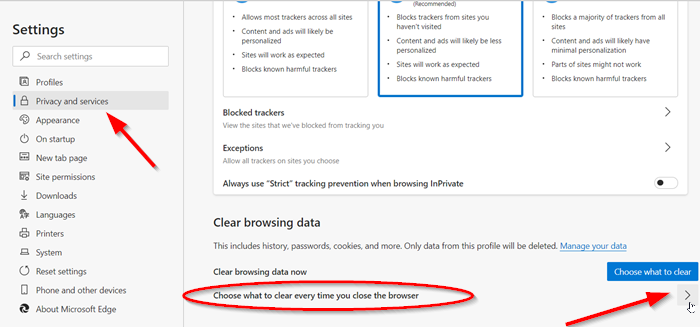
In the right pane scroll down to ‘Clear browsing data‘ section.
Here, choose the second heading – ‘Choose what to clear every time you close the browser‘.
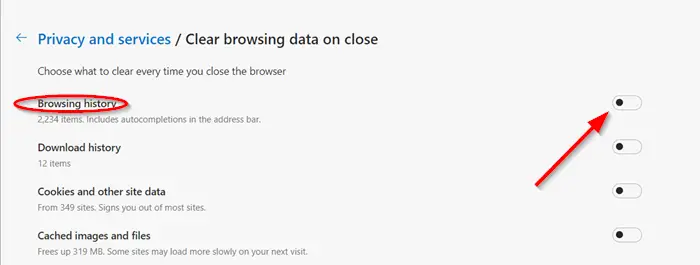
To delete or clear the browsing history of Edge on close, toggle the switch for ‘Browsing history‘ to ‘On’ position.
When enabled, the Edge browser will be configured to delete Microsoft Edge browsing history on exit automatically.
That’s it!
To test it, you can close your browser and re-open it to check whether everything is deleted or not. Now, every time you shut your Edge browser, this data will be removed automatically.
Using the Registry Editor to automatically clear browsing data when Edge closes
To automatically clear browsing data when Edge closes, using the Registry, follow these steps-
- Search for regedit in the Taskbar search box and click the individual result.
- Click the Yes button.
- Navigate to Microsoft in HKEY_LOCAL_MACHINE.
- Right-click on Microsoft > New > Key.
- Name it as Edge.
- Right-click on Edge > New > Key.
- Name it as Recommended.
- Right-click on Recommended > New > DWORD (32-bit) Value.
- Name it as ClearBrowsingDataOnExit.
- Double-click on it and set the Value data as 1.
- Click the OK button.
Open Registry Editor. Next, navigate to the following path-
HKEY_LOCAL_MACHINE\SOFTWARE\Policies\Microsoft
Here you have to create two keys. For that, right-click on Microsoft and select New > Key. Name it as Edge.
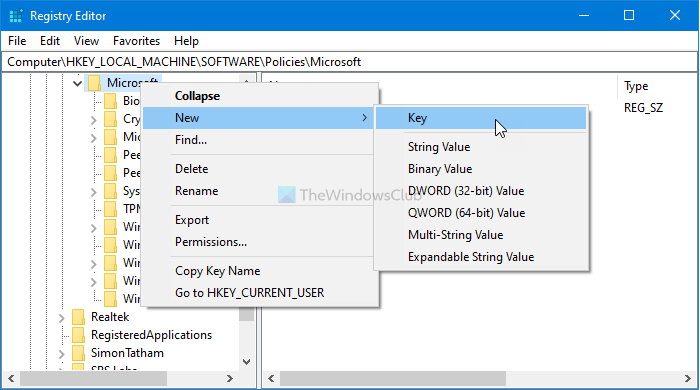
Then, right-click on the Edge key, select New > Key, and name it as Recommended.
Now you have to create a DWORD Value inside the Recommended key. For that, right-click on the Recommended > New > DWORD (32-bit) Value, and name it as ClearBrowsingDataOnExit.
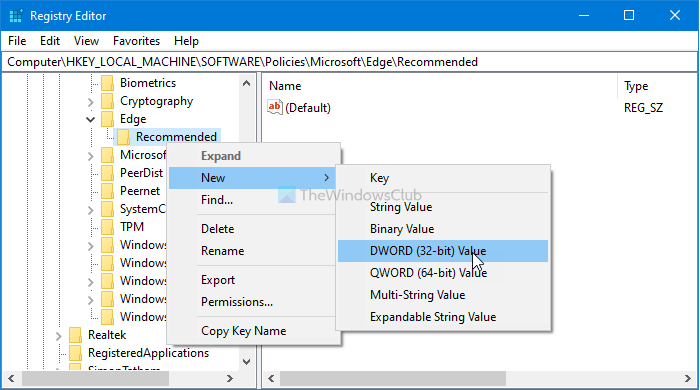
By default, it comes with 0 as the Value data. Double-click on it, enter 1 as the Value data and click the OK button.
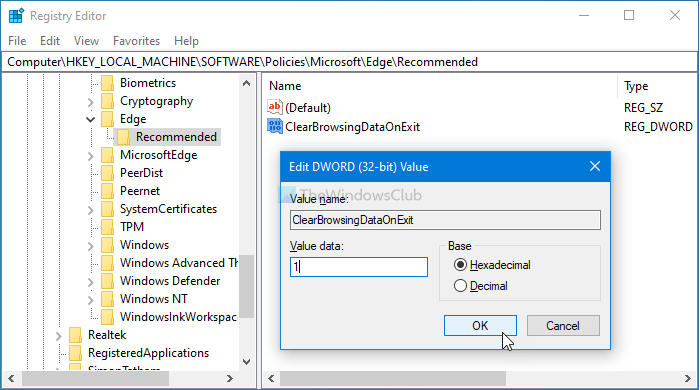
Similarly, if you want to delete cached images and files when Edge exits automatically, you have to create a DWORD Value ClearCachedImagesAndFilesOnExit and set the Value data 1. In case you want to keep your browsing data, you can open the ClearBrowsingDataOnExit, and set the Value data as 0.
Using Group Policy to automatically clear browsing data when Edge closes
If you want to do the same via Local Group Policy Editor, you must download Group Policy Templates for the Edge browser.
To automatically clear browsing data when Edge closes using Group Policy, follow these steps-
- Press Win+R to open the Run prompt.
- Type gpedit.msc and press the Enter button.
- Navigate to Microsoft Edge – Default Settings in Computer Configuration.
- Double-click on the Clear browsing data when Microsoft Edge closes setting.
- Select the Enabled option.
- Click the OK button.
Press Win+R, type gpedit.msc, and press the Enter button. Next, navigate to the following path-
Computer Configuration > Administrative Templates > Classic Administrative Templates > Microsoft Edge - Default Settings
Double-click on the Clear browsing data when Microsoft Edge closes setting and select the Enabled option.
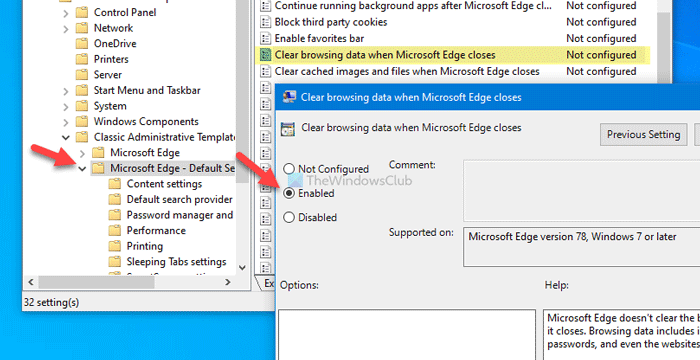
Next, click the OK button to save the change.
It is also possible to delete cached images and files on exit. For that, you have to enable the Clear cached images and files when Microsoft Edge closes setting.
In case you do not want to clear the browsing data on exit, open the same setting, and choose either Not Configured or the Disabled option.
If you use this solution, you need not use the Private browsing mode and keep using the normal mode. Also, you do not have to worry about deleting browsing data manually for privacy reasons.
TIP: You can make Microsoft Edge always start in InPrivate mode by editing the Windows Registry.